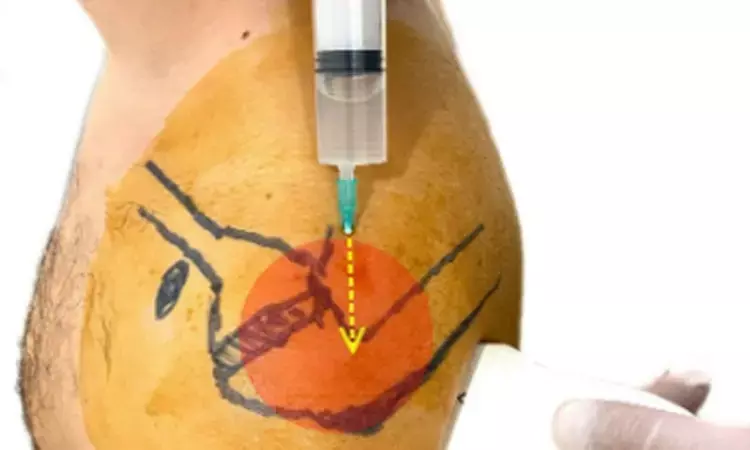- Home
- Medical news & Guidelines
- Anesthesiology
- Cardiology and CTVS
- Critical Care
- Dentistry
- Dermatology
- Diabetes and Endocrinology
- ENT
- Gastroenterology
- Medicine
- Nephrology
- Neurology
- Obstretics-Gynaecology
- Oncology
- Ophthalmology
- Orthopaedics
- Pediatrics-Neonatology
- Psychiatry
- Pulmonology
- Radiology
- Surgery
- Urology
- Laboratory Medicine
- Diet
- Nursing
- Paramedical
- Physiotherapy
- Health news
- Fact Check
- Bone Health Fact Check
- Brain Health Fact Check
- Cancer Related Fact Check
- Child Care Fact Check
- Dental and oral health fact check
- Diabetes and metabolic health fact check
- Diet and Nutrition Fact Check
- Eye and ENT Care Fact Check
- Fitness fact check
- Gut health fact check
- Heart health fact check
- Kidney health fact check
- Medical education fact check
- Men's health fact check
- Respiratory fact check
- Skin and hair care fact check
- Vaccine and Immunization fact check
- Women's health fact check
- AYUSH
- State News
- Andaman and Nicobar Islands
- Andhra Pradesh
- Arunachal Pradesh
- Assam
- Bihar
- Chandigarh
- Chattisgarh
- Dadra and Nagar Haveli
- Daman and Diu
- Delhi
- Goa
- Gujarat
- Haryana
- Himachal Pradesh
- Jammu & Kashmir
- Jharkhand
- Karnataka
- Kerala
- Ladakh
- Lakshadweep
- Madhya Pradesh
- Maharashtra
- Manipur
- Meghalaya
- Mizoram
- Nagaland
- Odisha
- Puducherry
- Punjab
- Rajasthan
- Sikkim
- Tamil Nadu
- Telangana
- Tripura
- Uttar Pradesh
- Uttrakhand
- West Bengal
- Medical Education
- Industry
Intra-articular lidocaine as good as IV sedation for acute anterior shoulder dislocation closed reduction

The most frequent kind of joint dislocation seen in the emergency department (ED) is an anterior shoulder dislocation, which accounts for 95% of all shoulder dislocations. Muscle relaxation and patient cooperation are crucial for reduction to be successful. As a result, analgesia is often needed. For the reduction of an anterior shoulder dislocation, intra-articular lidocaine and intravenous sedation (IV sedation) are two analgesic options. Intra-articular lidocaine may be a useful substitute for intravenous sedation for minimizing anterior shoulder dislocations, especially in situations when intravenous sedation is contraindicated or impractical. This was shown by a recent metaanalysis.
Reference lists were hand-searched in addition to electronic searches of MEDLINE and EMBASE (1946–September 2021). Included were randomized controlled studies (RCTs) that compared IAL and IV sedation for the prevention of acute anterior shoulder dislocations in ED patients under the age of 15. The following outcomes were of particular interest: a successful reduction, adverse events, duration of stay in the emergency department, pain ratings, procedure time, ease of reduction, patient satisfaction, and cost. Abstracts were evaluated, research quality was determined, and data were retrieved separately by two reviewers. Following the pooling of the data using random-effects models, the mean differences and risk ratios (RR) with 95% confidence intervals (CIs) were reported. A total of 630 participants from 12 RCTs (303 under IV sedation and 327 with IAL) were included. There was no difference in reduction success between IAL and IV sedation (RR 0.93; 95% CI 0.86-1.01, I2 = 69%). There was also no difference in pain scores following analgesia or ease of reduction.
In this systematic review and meta-analysis of 12 studies involving a total of 630 patients (327 in the intra-articular lidocaine group and 303 in the IV sedation group), we discovered that intra-articular lidocaine may be just as effective as IV sedation in successfully reducing anterior shoulder dislocations in the emergency department (ED) with fewer side effects, a shorter length of stay in the ED, and no difference in pain scores or ease of reduction. With intra-articular lidocaine, patient satisfaction was, however, lower. Depending on the ED context a doctor is working in, intra-articular lidocaine and IV sedation have various benefits. Nevertheless, both techniques are helpful for emergency care practitioners.
The results imply that IV sedation is connected to increased patient satisfaction and shorter procedure times. When treating a patient who has had a challenging reduction in the past, has significant anxiety about remaining alert during the procedure, has a risk of local anesthetic allergy or toxicity, or the provider is uncomfortable with joint injection technique, IV sedation may be the best option in a setting with adequate resources. Although intra-articular lidocaine may be associated with lower patient satisfaction, it may be advantageous to consider it in a variety of settings, including low-resource settings (such as remote communities or single coverage EDs) where access to IV sedation drugs or equipment may be restricted or impractical.
Reference –
Sithamparapillai, A., Grewal, K., Thompson, C. et al. Intra-articular lidocaine versus intravenous sedation for closed reduction of acute anterior shoulder dislocation in the emergency department: a systematic review and meta-analysis. Can J Emerg Med 24, 809–819 (2022). https://doi.org/10.1007/s43678-022-00368-z
MBBS, MD (Anaesthesiology), FNB (Cardiac Anaesthesiology)
Dr Monish Raut is a practicing Cardiac Anesthesiologist. He completed his MBBS at Government Medical College, Nagpur, and pursued his MD in Anesthesiology at BJ Medical College, Pune. Further specializing in Cardiac Anesthesiology, Dr Raut earned his FNB in Cardiac Anesthesiology from Sir Ganga Ram Hospital, Delhi.
Dr Kamal Kant Kohli-MBBS, DTCD- a chest specialist with more than 30 years of practice and a flair for writing clinical articles, Dr Kamal Kant Kohli joined Medical Dialogues as a Chief Editor of Medical News. Besides writing articles, as an editor, he proofreads and verifies all the medical content published on Medical Dialogues including those coming from journals, studies,medical conferences,guidelines etc. Email: drkohli@medicaldialogues.in. Contact no. 011-43720751


